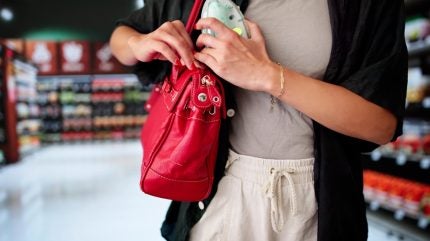
Retailers across the UK are deploying “VAR-style” cameras at self-service tills in a bid to combat a record-breaking surge in shoplifting.
Borrowing from football’s Video Assistant Referee (VAR) system, the technology records checkout activity in real time and replays moments where an item may have been missed, scanned incorrectly, or bypassed altogether. The goal: to make would-be shoplifters confront their actions in the moment — often literally watching themselves steal.

Discover B2B Marketing That Performs
Combine business intelligence and editorial excellence to reach engaged professionals across 36 leading media platforms.
Tesco and Sainsbury’s are among the first major UK supermarkets to trial this technology, citing its potential to reduce theft and improve scanning accuracy.
How VAR-style tech works at the checkout
At the heart of the system is a small, AI-enhanced camera mounted above the self-checkout area. As customers scan and bag their items, the camera uses computer vision to track the movement of each product.
If it detects that an item has been placed in the bagging area without being properly scanned — whether by accident or intent — the system automatically triggers a short on-screen video replay of the event. This is how shoppers “see themselves stealing”: the footage shows their own hands skipping a scan or misaligning a barcode, replayed just seconds after it happens.

US Tariffs are shifting - will you react or anticipate?
Don’t let policy changes catch you off guard. Stay proactive with real-time data and expert analysis.
By GlobalDataAn on-screen message such as “Looks like that last item didn’t scan” accompanies the footage, nudging the customer to review their transaction. Even small items like packets of herbs or batteries have triggered the alert, underscoring the system’s precision.
Unlike traditional CCTV, which is reviewed after the fact, these systems are interactive and real-time — designed not just to observe but to influence customer behavior at the point of sale.
Retail analysts note that the psychological effect of seeing oneself caught in the act, even in a replay, can be a powerful deterrent — especially when it’s framed as a gentle correction rather than an accusation.
Shoplifting on the rise: the retail response
According to the Office for National Statistics (ONS), police in England and Wales logged over 516,000 shoplifting offences in 2024 — a 20% year-on-year increase and the highest level since modern records began in 2003.
The British Retail Consortium (BRC) warns that theft, along with associated abuse toward staff, has reached crisis levels. While major retailers collectively report tens of millions of incidents annually, many go unreported due to limited police response.
The BRC estimates shoplifting now costs UK retailers more than £2.2 billion per year — including the expense of added security.
In this climate, the rollout of VAR-style surveillance reflects a shift in strategy. Rather than relying on reactive measures like locked display cases or random staff checks, retailers are turning to proactive, tech-driven systems that engage directly with customers during checkout.
Balancing security and experience
Tesco and Sainsbury’s both confirmed that the VAR-style systems are part of broader efforts to improve checkout accuracy while maintaining a smooth experience for honest shoppers.
A Sainsbury’s spokesperson said decisions about security technology take into account customer convenience as well as loss prevention. Tesco echoed that view, stating the system helps customers “spot when something hasn’t scanned properly.”
Though official performance data is not yet available, early feedback suggests the technology is helping to curb both accidental and intentional theft.
Retail experts believe its wider adoption could ultimately reduce the need for more disruptive security measures, such as locked cabinets for everyday items.
As the industry continues to grapple with rising retail crime, VAR-style cameras offer a novel — and often jarring — way to hold people accountable. While privacy concerns may arise, many retailers argue that the ability to show someone exactly what they just did, in real time, is a practical and proportionate response to a growing problem.





